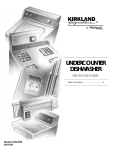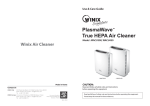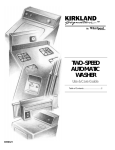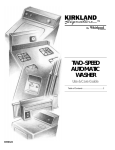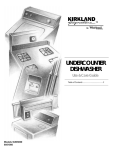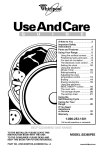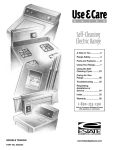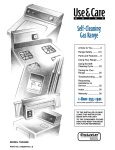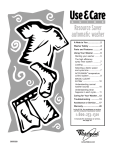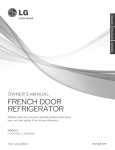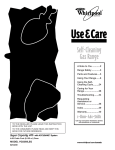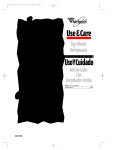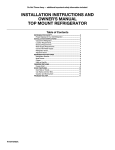Download Whirlpool Signature ST14CKCHW00 User's Manual
Transcript
14’ Top-Mount Refrigerator Table of Contents..................2 Réfrigérateur superposé de 14 po Table des matières..............25 2202048 TABLE OF CONTENTS Page A Note to You ..................................................................2 Refrigerator Safety .........................................................3 Proper Disposal of Your Old Refrigerator .....................4 Parts and Features .........................................................5 Installing Your Refrigerator.............................................6 Unpacking your refrigerator ..........................................6 Space requirements ....................................................6 A NOTE TO YOU Thank you for buying a KIRKLAND SIGNATURE appliance by Whirlpool Corporation. TM To ensure that you enjoy years of trouble-free operation, we developed this Use and Care Guide. It is full of valuable information about how to operate and maintain your appliance properly and safely. Please read it carefully. Electrical requirements ................................................7 Door closing and alignment..........................................8 Using Your Refrigerator .................................................9 Setting the control ........................................................9 Changing the control settings.......................................9 Ensuring proper air circulation....................................10 Removing the drop-in door trim..................................10 Adjusting the refrigerator shelves...............................11 Removing the crisper and crisper cover.....................11 Removing the meat drawer and cover .......................12 Adjusting the freezer shelf..........................................12 Changing the light bulb...............................................13 Reversing the door swing...........................................13 Understanding the sounds you may hear ..................15 Saving energy.............................................................15 Caring for Your Refrigerator ........................................16 Cleaning your refrigerator...........................................16 Vacation and moving care ..........................................18 Record your model’s information Write down the following information about your refrigerator to better help you obtain assistance or service if you ever need it. You will need to know your complete model number and serial number. You can find this information on the model and serial number label/plate. If you need assistance or service, first see the “Troubleshooting” section of this book. After checking “Troubleshooting,” additional help can be found by checking the “Requesting Assistance or Service” section. Dealer name________________________________________ Address ____________________________________________ Phone number______________________________________ Model number ______________________________________ Serial number ______________________________________ Purchase date ______________________________________ (See the “Parts and Features” section for model and serial number label/plate location.) Power interruptions.....................................................18 Food Storage Guide .....................................................19 Troubleshooting .............................................................21 If You Need Assistance or Service ..............................23 Warranty ........................................................................24 2 Keep this book and your sales slip together for future reference. REFRIGERATOR SAFETY YOUR SAFETY AND THE SAFETY OF OTHERS IS VERY IMPORTANT. We have provided many important safety messages in this manual and on your appliance. Always read and obey all safety messages. This is the safety alert symbol. This symbol alerts you to hazards that can kill or hurt you and others. All safety messages will be preceded by the safety alert symbol and the word “DANGER” or “WARNING.” These words mean: You will be killed or seriously injured if you don’t follow instructions. wDANGER You can be killed or seriously injured if you don’t follow instructions. wWARNING All safety messages will identify the hazard, tell you how to reduce the chance of injury, and tell you what can happen if the instructions are not followed. IMPORTANT SAFETY INSTRUCTIONS WARNING: To reduce the risk of fire, electric shock, or injury when using your refrigerator, follow these basic precautions: • Plug into a grounded 3 prong outlet. • Use nonflammable cleaner. • Do not remove ground prong. • Keep flammable materials and vapors, such as gasoline, away from refrigerator. • Do not use an adapter. • Use two or more people to move and install refrigerator. • Do not use an extension cord. • Disconnect power before servicing. • Unplug refrigerator before installing ice maker. • Replace all panels before operating. • Remove doors from your old refrigerator. • Use a sturdy glass when dispensing ice or water (on some models). SAVE THESE INSTRUCTIONS 3 PROPER DISPOSAL OF YOUR OLD REFRIGERATOR wWARNING Suffocation Hazard Remove doors from your old refrigerator. Failure to do so can result in death or brain damage. IMPORTANT: Child entrapment and suffocation are not problems of the past. Junked or abandoned refrigerators are still dangerous... even if they will sit for “just a few days.” If you are getting rid of your old refrigerator, please follow the instructions below to help prevent accidents. BEFORE YOU THROW AWAY YOUR OLD REFRIGERATOR OR FREEZER: • Take off the doors. • Leave the shelves in place so that children may not easily climb inside. 4 PARTS AND FEATURES NOTE: This manual covers several different models. The refrigerator you have purchased may have some or all of the parts and features listed below. Partial width shelf (on some models) Door shelves Ice cube trays (on some models) Magnetic door gaskets Light switch Temperature control Model and serial number label (on side wall) Dairy compartment Meat drawer cover (Solid plastic) Meat drawer (on some models) Adjustable wire shelves Door shelves Crisper cover Crisper drawers Leveling rollers (not shown) Other parts and features (not shown in illustration above/optional on some models) Automatic Ice maker 5 INSTALLING YOUR REFRIGERATOR SPACE REQUIREMENTS wWARNING It is important to prepare your refrigerator for use. This section tells you how to clean it, install it, connect it to a power source, and level it. UNPACKING YOUR REFRIGERATOR wWARNING Excessive Weight Hazard Use two or more people to move and install refrigerator. Failure to do so can result in back or other injury. Removing packaging materials • Remove tape and any labels from your refrigerator before using (except the model and serial number label). To remove any remaining tape or glue, rub the area • briskly with your thumb. Tape or glue residue can also be easily removed by rubbing a small amount of liquid dish soap over the adhesive with your fingers. Wipe with warm water and dry. • Do not use sharp instruments, rubbing alcohol, flammable fluids, or abrasive cleaners to remove tape or glue. These products can damage the surface of your refrigerator. For more information, see “Important Safety Instructions” in the “Refrigerator Safety” section. Explosion Hazard Keep flammable materials and vapors, such as gasoline, away from refrigerator. Failure to do so can result in death, explosion or fire. • Allow 3 inches (7.5 cm) between the overhead cabinets and the refrigerator top, and allow 1⁄2 inch (1.25 cm) on each side. • Allow at least 1 inch (2.5 cm) between the refrigerator condenser coils on the back and the wall. • If you are installing your refrigerator next to a fixed wall, leave 2 inches (5.08 cm) minimum on the hinge side (depending on your model) to allow for the door to swing open. IMPORTANT: • Do not remove any permanent instruction labels inside your refrigerator. Cleaning before use After you remove all of the packaging materials, clean the inside of your refrigerator before using it. See the cleaning instructions in the “Caring For Your Refrigerator” section for more information. 3-inch (7.5 cm) minimum at top and 1⁄2 -inch (1.25 cm) minimum at sides 6 ELECTRICAL REQUIREMENTS wWARNING Electrical Shock Hazard Plug into a 3 prong grounded outlet. Do not remove ground prong. Do not use an adapter. Do not use an extension cord. Failure to follow these instructions can result in death, fire, or electrical shock. Before you move your refrigerator into its final location, it is important to make sure you have the proper electrical connection. Recommended Grounding Method A 115 Volt/60 Hz AC only 15 to 20 ampere fused and properly grounded electrical supply is required. It is recommended that a separate circuit serving only your refrigerator be provided. Use an outlet that cannot be turned off by a switch. Do not use an extension cord. NOTE: Before performing any type of installation, cleaning, or removing a light bulb, turn the Temperature Control to OFF and then disconnect the refrigerator from the electrical source. When you are finished, connect the refrigerator to the electrical source and reset the Temperature Control to the desired setting. 7 DOOR CLOSING AND ALIGNMENT Door Closing Your refrigerator has 2 front adjustable rollers - one on the right and one on the left. If your refrigerator seems unsteady or you want the doors to close easier, adjust the refrigerator’s tilt using the instructions below: 1. Plug refrigerator power cord into a 3-prong grounded outlet. Move the refrigerator into its final position. 2. The two leveling screws are part of the front roller assemblies which are at the base of the refrigerator on either side. 3. Use a screwdriver to adjust the leveling screws. Turn the leveling screw to the right to raise that side of the refrigerator or turn the leveling screw to the left to lower that side. It may take several turns of the leveling screws to adjust the tilt of the refrigerator. NOTE: Having someone push against the top of the refrigerator takes some weight off the leveling screws and rollers. This makes it easier to adjust the screws. 4. Open both doors again and check to make sure that they close as easily as you like. If not, tilt the refrigerator slightly more to the rear by turning both leveling screws to the right. It may take several more turns, and you should turn both leveling screws the same amount. Door Alignment If the space between your doors looks uneven, you can adjust it using the instructions below: 1. Pry off the top hinge cover. 2. Loosen the top hinge screws using a 5⁄16-inch socket or wrench. 3. Have someone hold the door in place or put a spacer between the doors while you tighten the top hinge screws. 4. Replace the top hinge cover. 8 USING YOUR REFRIGERATOR SETTING THE CONTROL The control for the refrigerator and freezer is located in the top of the refrigerator section. It controls the temperature in both the refrigerator and freezer compartments. When you first install your refrigerator, set the Temperature Control to 3 (normal). Temperature Control adjustments range from 1 (warmest) to 5 (coldest). 1 off 3 normal 5 coldest CHANGING THE CONTROL SETTINGS If you need to adjust temperatures in the refrigerator or freezer, use the settings listed in the chart below as a guide. Wait at least 24 hours between adjustments. NOTES: • The built-in exterior moisture control continuously guards against moisture build-up on the outside of the refrigerator cabinet. • Turning the Temperature Control to OFF stops cooling in both the refrigerator and the freezer compartments, but does not disconnect the refrigerator from the power supply. IMPORTANT: Give the refrigerator time to cool down completely before adding food. This could take several hours. If you add food before the refrigerator has cooled completely your food may spoil. Turning the control to a higher than recommended setting will not cool the compartment any faster. The control settings indicated in “Changing the Control Settings” section should be correct for normal household refrigerator usage. The control is set correctly when milk or juice is as cold as you like and when ice cream is firm. Condition/ Reason: RECOMMENDED ADJUSTMENT: Refrigerator section too warm • Door opened often • Large amount of food added • Room temperature too warm Turn Temperature Control to next higher number Freezer section too warm/ ice not made fast enough • Door opened often • Large amount of food added • Very cold room temperature (can’t cycle often enough) • Heavy ice usage Turn Temperature Control to next higher number Refrigerator section too cold • Controls not set correctly for your conditions Turn Temperature Control to next lower number Freezer section too cold • Controls not set correctly for your conditions Turn Temperature Control to next lower number 9 ENSURING PROPER AIR CIRCULATION In order to ensure proper temperatures, you need to permit air flow between the two sections. As shown in the illustration, cool air enters through the bottom of the freezer section (1) and moves up. Most of the air then flows through the freezer section vents (2) and recirculates under the freezer floor (3). The rest of the air enters the fresh section through the top vent (4). Do not block any of these vents (1, 2, 3, or 4) with food packages. If the vents are blocked, air flow will be prevented and temperature and moisture problems may occur. IMPORTANT: Because air circulates between both sections, any odors formed in one section will transfer to the other. You must thoroughly clean both sections to eliminate odors. To prevent odor transfer and drying out of food, wrap or cover foods tightly. (See the “Food Storage Guide” section for details.) REMOVING THE DROP-IN DOOR TRIM To remove the trim piece: 1. Remove all items from the shelf. 2. Pull straight up on each end of the trim piece. To replace the trim piece: 1. Locate each end of the trim piece above the trim pocket opening. 2. Push the trim ends straight down until they stop. 3. Replace items on the shelf. 10 2 3 1 1 4 ADJUSTING THE REFRIGERATOR SHELVES To remove the shelves: 1. Remove items from the shelf. 2. Slide shelf straight out to the stop. 3. Depending on your model, lift the back or front of the shelf over the stop. 4. Slide shelf out the rest of the way. To replace the shelves: 1. Slide back of shelf into shelf track in wall of cabinet. 2. Guide front of shelf into shelf track. 3. Slide shelf in all the way. REMOVING THE CRISPER(S) AND COVER To remove the crisper(s): 1. Slide crisper(s) straight out to the stop. 2. Lift the front. 3. Slide out the rest of the way. 4. Replace in reverse order. To remove the plastic cover: 1. Lift cover front and remove the cover support. 2. Lift cover up and slide out. To replace the cover: 1. Fit cover tabs into lowest cabinet slots and push in. Lower the front retainers into place. 2. Insert cover support (with the long tab toward the front) into the groove on the underside of the cover. NOTE: If the support needs adjustment, turn base clockwise to raise or counterclockwise to lower. Tabs Cover support Lower 11 REMOVING THE MEAT DRAWER AND COVER (on some models) To remove the meat drawer: 1. Slide meat drawer out to the stop. 2. Lift front of meat drawer. 3. Slide meat drawer out the rest of the way. 4. Replace in reverse order. To remove the cover: 1. Remove the meat drawer. 2. Push cover back to release rear clips from shelf. 3. Tilt cover up at front. 4. Pull cover forward and out. To replace the cover: 1. Fit notches and clips on underside of cover over rear and center cross bars on shelf. 2. Lower cover into place. 3. Pull cover forward to secure rear clips onto shelf. 4. Replace the meat drawer. ADJUSTING THE FREEZER SHELF (on some models) To remove the shelf: 1. Remove items from the shelf. 2. Lift back of shelf over stop. 3. Slide shelf straight out. 12 To replace the shelf: 1. Slide back of shelf into shelf tracks on walls of cabinet. 2. Slide shelf in all the way. CHANGING THE LIGHT BULB To change the refrigerator light: 1. Unplug refrigerator or disconnect power. 2. Reach behind the Control Panel and remove the bulb. 3. Replace the bulb with a 40-watt appliance bulb. 4. Plug in refrigerator or reconnect power. NOTE: Not all appliance bulbs will fit your refrigerator. Be sure to replace the bulb with one of the same size and shape. REVERSING THE DOOR SWING TOOL NEEDED: 5⁄16-inch hex-head socket wrench, No. 2 Phillips screwdriver, flat-head screwdriver, 1⁄2-inch openend wrench. SUGGESTION: Reversing the door swing should be performed by a qualified person. IMPORTANT INFORMATION: • Before you begin, turn refrigerator OFF, unplug it, and remove any food from door shelves. • When removing hinges, keep doors closed until ready to lift free from cabinet. • To remove doors, start at the top hinge and work your way down. • To replace doors, start at the bottom hinge and work your way up. • Line up doors so they are centered between the sides of the cabinet and parallel with each other. • Seal all unused openings with screws or plastic plugs. Moisture will enter any openings. NOTE: After the doors are reversed, reinstall the handles. If the doors are not shutting on their own, see the “Door Closing and Alignment” section. TOP HINGE Cover Screws Top hinge Spacer Screws CENTER HINGE Door stop Spacer Shim Hinge Pin Screws Spacer Hinge Bracket BOTTOM HINGE Door stop Spacer Screw Shim Hinge pin Screws Plug continued on next page 13 Reversing the door swing (cont.) Reversing the handles Plugs Screws (A) Top endcap Stick-on shim (on some models) Stick-on shim (on some models) Bottom endcap Screws (A) Screws (A) Plug Top endcap Plug Stick-on shim (on some models) Bottom Endcap Stick-on shim Screw (B) Screw cover Plug 14 A B Oval Sealing Screw (Use on top of doors) Handle Screws (Use on top and bottom of handle) UNDERSTANDING THE SOUNDS YOU MAY HEAR Your new refrigerator may make sounds that your old one didn’t. Because the sounds are new to you, you might be concerned about them. Don’t be. Most of the new sounds are normal. Hard surfaces like the floor, walls, and cabinets can make the sounds seem louder. The following describes the kinds of sounds that might be new to you, and what may be making them. Water sounds When the refrigerator stops running, you may hear gurgling in the tubing for a few minutes after it stops. You may also hear defrost water running into the defrost water pan. Running sounds Your refrigerator has a high-efficiency compressor and motor. It will run longer than older designs. It may even seem to run most of the time. Slight hum, soft hiss You may hear the refrigerator’s fan motor and moving air. Clicking or snapping sounds The thermostat makes a definite click when the refrigerator stops running. It also makes a sound when the refrigerator starts. The defrost timer will click when the defrost cycle starts. SAVING ENERGY There are ways that you can help your refrigerator run more efficiently. • Check the door gaskets for a tight seal. Leveling the cabinet will ensure a proper seal. • Clean the condenser coils regularly. A coil cleaning brush is available for purchase (Part number 4210463). • Open the door as few times as possible. • Don’t block the air vents in the freezer and refrigerator so that cold air cannot flow freely. See the “Ensuring proper air circulation” section. • Do not set your refrigerator and freezer at a colder setting than is needed. Keep the refrigerator control at the lowest number setting that keeps milk or juice as cold as you like and ice cream firm. • Do not put your refrigerator next to a heat source, such as a range, water heater, furnace, radiator, or in direct sunlight. 15 CARING FOR YOUR REFRIGERATOR Your refrigerator is built to give you many years of dependable service. However, there are a few things you can do to help extend its product life. This section tells you how to clean your refrigerator and what to do when going on vacation, moving, or during a power outage. CLEANING YOUR REFRIGERATOR Both the refrigerator and freezer sections defrost automatically. However, clean both sections about once a month to prevent odors from building up. Wipe up spills immediately. To clean your refrigerator: • Unplug refrigerator or disconnect power. • Remove all removable parts from inside, such as shelves, crispers, etc. • Use a clean sponge or soft cloth and a mild detergent in warm water. Do not use abrasive or harsh cleaners. • Hand wash, rinse, and dry all surfaces thoroughly. • Plug in refrigerator or reconnect power. 16 wWARNING Explosion Hazard Use nonflammable cleaner. Failure to do so can result in death, explosion, or fire. Additional cleaning tips are listed below: PART WHAT TO USE HOW TO CLEAN Removable parts (shelves, crisper, etc.) Sponge or cloth with mild detergent and warm water • Hand wash, rinse, and dry thoroughly. Outside Sponge, cloth, or paper towel with mild detergent, warm water, and an appliance wax (or good auto paste wax) • Wash outside of cabinet. Do not use abrasive or harsh cleaners. • Wipe and dry thoroughly. • Wax painted metal surfaces at least twice a year. Apply wax with a clean, soft cloth. Waxing painted metal surfaces provides rust protection. Do not wax plastic parts. Inside walls (allow freezer to warm up so cloth won’t stick) Sponge, soft cloth, or paper towel with baking soda or mild detergent and warm water • Wash with mixture of warm water and – mild detergent, or – baking soda (2 tablespoons [26 g] to 1 quart [.95 L] of water). • Wipe and dry thoroughly. Door liners and gaskets Sponge, soft cloth, or paper towel with mild detergent and warm water • Wash, wipe, and dry thoroughly. DO NOT USE cleaning waxes, concentrated detergents, bleaches, or cleaners containing petroleum on plastic parts. Plastic parts (covers and panels) Soft, clean sponge or soft, clean cloth with mild detergent and warm water Defrost pan (behind refrigerator on top of motor) Sponge or cloth with mild detergent and warm water • Wash, wipe, and dry thoroughly. DO NOT USE paper towels, window sprays, scouring cleansers, or flammable fluids. These can scratch or damage material. • Roll refrigerator out away from the wall. • Wash, rinse, and dry thoroughly. Do not remove the defrost pan to clean it. • Roll refrigerator back into place. Make sure to leave 1 inch (2.5 cm) between the cabinet back and the wall. • Check to see if the refrigerator is level. Condenser coils Floor under refrigerator Vacuum cleaner with extended narrow attachment Floor cleaners • Roll refrigerator out away from the wall. • Vacuum coils when dusty or dirty. Coils may need to be cleaned as often as every other month. • Roll refrigerator back into place. Make sure to leave 1 inch (2.5 cm) between the cabinet back and the wall. • Check to see if the refrigerator is level. • Roll refrigerator out away from the wall. • Clean floor. • Roll refrigerator back into place. • Check to see if the refrigerator is level. 17 VACATION AND MOVING CARE Vacation Moving If you choose to leave the refrigerator on while you’re away, use these steps to prepare your refrigerator before you leave. 1. Use up any perishables and freeze other items. 2. If your refrigerator has an automatic ice maker: • Raise ice maker arm to OFF (up) position. • Shut off water supply to the ice maker. 3. Empty the ice bin. When you are moving your refrigerator to a new home, follow these steps to prepare it for the move. 1. If your refrigerator has an automatic ice maker: • Turn off the water supply to the ice maker at least one day ahead of time. • Disconnect the water line from the back of the refrigerator. • When the last load of ice drops, raise the ice maker arm to the OFF (up) position. 2. Remove all food from the refrigerator and pack all frozen food in dry ice. 3. Turn the Temperature Control to OFF. 4. Unplug the refrigerator. 5. Empty water from the defrost pan. 6. Clean, wipe, and dry thoroughly. 7. Take out all removable parts, wrap them well, and tape them together so they don’t shift and rattle during the move. 8. Depending on the model, raise the front of the refrigerator so it rolls easier OR screw in the leveling legs so they don’t scrape the floor. See the “Door Closing and Alignment” section. 9. Tape the doors shut and the power cord to the refrigerator cabinet. When you get to your new home, put everything back and refer to “Installing Your Refrigerator” for preparation instructions. Also, if your refrigerator has an automatic ice maker, remember to reconnect the water supply to the refrigerator. If you choose to turn the refrigerator off before you leave, follow these steps to prepare your refrigerator. 1. Remove all food from the refrigerator. 2. If your refrigerator has an automatic ice maker: • Turn off the water supply to the ice maker at least one day ahead of time. • When the last load of ice drops, raise the ice maker arm to the OFF (up) position. 3. Turn the Temperature Control to OFF and then unplug the refrigerator. 4. Clean refrigerator, wipe it, and dry well. 5. Tape rubber or wood blocks to the tops of both doors to prop them open far enough for air to get in. This stops odor and mold from building up. POWER INTERRUPTIONS If the electricity in your house goes off, call the power company and ask how long it will be off. 1. If the power will be out for 24 hours or less, keep both doors closed to help foods stay cold and frozen. 2. If the power will be out for more than 24 hours: (a) Remove all frozen food and store it in a frozen food locker. OR (b) Place 2 lbs. (907 g) of dry ice in freezer for every cubic foot (28.32 L) of freezer space. This will keep the food frozen for two to four days. While handling dry ice, wear gloves to protect your hands from ice burns. 18 OR (c) If neither a food locker nor dry ice is available, use up or can perishable food at once. NOTE: A full freezer stays cold longer than a partly filled one. A freezer full of meat stays cold longer than a freezer full of baked goods. If food contains ice crystals, it may be safely refrozen, although the quality and flavor may be affected. If the condition of the food is poor, or if you feel it is unsafe, dispose of it. FOOD STORAGE GUIDE STORING FRESH FOOD Wrap or store food in the refrigerator in airtight and moisture-proof material unless otherwise noted. This prevents food odor and taste transfer throughout the refrigerator. For dated products, check code date to ensure freshness. Butter or margarine Keep opened butter in covered dish or closed compartment. When storing an extra supply, wrap in freezer packaging and freeze. Cheese Store in the original wrapping until you are ready to use it. Once opened, rewrap tightly in plastic wrap or aluminum foil. Milk Wipe milk cartons. For best storage, place milk on interior shelf. Eggs Store in original carton on interior shelf. Fruit Wash, let dry, and store in refrigerator in plastic bags or crisper. Do not wash or hull berries until they are ready to use. Sort and keep berries in original container in a crisper, or store in a loosely closed paper bag on a refrigerator shelf. Vegetables with skins (carrots, peppers) Place in plastic bags, or plastic container and store in crisper Fish Use fresh fish and shellfish the same day as purchased. Meat Store most meat in original wrapping as long as it is airtight and moisture-proof. Rewrap if necessary. See the following for storage times. When storing meat longer than the times given, freeze the meat. Chicken ........................................................1-2 days Ground beef ..................................................1-2 days Cold cuts ......................................................3-5 days Steaks/roasts ................................................3-5 days Variety meats .............................................. ..1-2 days Cured meats................................................7-10 days Leftovers Cover leftovers with plastic wrap or aluminum foil. Plastic containers with tight lids can also be used. Leafy vegetables Remove store wrapping and trim or tear off bruised and discolored areas. Wash in cold water and drain. Place in plastic bag or plastic container and store in crisper. Continued on next page 19 STORING FROZEN FOOD The freezer section is designed for storing commercially frozen food and for freezing food at home. NOTE: For further information about preparing food for freezing or food storage times, check a freezer guide or reliable cookbook. Packaging Successful freezing depends on the correct packaging. When you close and seal the package you must not allow air or moisture in or out. If you do, you could have food odor and taste transfer throughout the refrigerator, and also dry out frozen food. Packaging recommendations: • Rigid plastic containers with tight-fitting lids • Straight-sided canning/freezing jars • Heavy-duty aluminum foil • Plastic-coated paper • Non-permeable plastic wraps (made from saran film) • Specified freezer self-sealing plastic bags Follow package or container instructions for proper freezing methods. Do not use: • Bread wrappers • Non-polyethylene plastic containers • Containers without tight lids • Wax paper or wax-coated freezer wrap • Thin, semi-permeable wrap 20 Freezing Your freezer will not quick-freeze any large quantity of food. Put no more unfrozen food into the freezer than will freeze within 24 hours (about 2 to 3 lbs of food per cubic foot [907-1,350 g per liter] of freezer space). Leave enough space in the freezer for air to circulate around packages. Also leave enough room at the front so the door can close tightly. Storage times vary according to the quality and type of food, the type of packaging used (airtight and moisture-proof), and the storage temperature. Ice crystals inside a sealed package are normal. It means that moisture in the food and air inside the package have condensed, creating ice crystals. TROUBLESHOOTING Try the solutions suggested here first in order to avoid the cost of an unnecessary service call. Your refrigerator will not operate • The power supply cord is unplugged. Firmly plug the cord into a live outlet with proper voltage. • A household fuse or circuit breaker has tripped. Replace the fuse or reset the circuit. • The refrigerator control is turned to the “OFF” position. Refer to the “Setting the Control” section. • The refrigerator is defrosting. Recheck to see if the refrigerator is operating in 30 minutes. Your refrigerator will regularly run an automatic defrost cycle. The lights do not work • The power supply cord is unplugged. Firmly plug the cord into a live outlet with proper voltage. • A light bulb is loose in the socket. Turn the refrigerator control to OFF. Disconnect the refrigerator from the electrical supply. Gently remove the bulb and reinsert. Then reconnect the refrigerator to the electrical supply and reset the refrigerator control. • A light bulb has burned out. Replace with an appliance bulb of the same wattage, size, and shape. See the “Changing the Light Bulbs” section. There is water in the defrost drain pan • The refrigerator is defrosting. The water will evaporate. It is normal for water to drip into the defrost pan. • It is more humid than normal. Expect that the water in the defrost pan will take longer to evaporate. This is normal when it is hot or humid. The motor seems to run too much • The room temperature is hotter than normal. Expect the motor to run longer under warm conditions. At normal room temperatures, expect your motor to run about 40% to 80% of the time. Under warmer conditions, expect it to run even more of the time. • A large amount of food has just been added to the refrigerator. Adding a large amount of food warms the refrigerator. It is normal for the motor to run longer in order to cool the refrigerator back down. See the “Food Storage Guide” section. • The doors are opened often. Expect the motor to run longer when this occurs. In order to conserve energy, try to get everything you need out of the refrigerator at once, keep food organized so it is easy to find, and close the door as soon as the food is removed. • The control is not set correctly for the surrounding conditions. Refer to the “Setting the Control” section. • The doors are not closed completely. Push the doors firmly shut. If they will not shut all the way, see “The doors will not close completely” later in this section. • The condenser coils are dirty. This prevents air transfer and makes the motor work harder. Clean the condenser coils. Refer to the “Cleaning Your Refrigerator” section. NOTE: Your new refrigerator will run longer than your old one due to its high efficiency motor. The refrigerator seems to make too much noise • The sounds may be normal for your refrigerators. Refer to the “Understanding Sounds You May Hear” section. The ice maker is not producing ice • The freezer temperature is not cold enough to produce ice. Wait 24 hours after hook-up for ice production. See the “Setting the Control” section. • The ice maker arm is in the “OFF” (arm up) position. Lower arm to the “ON” (arm down) position. See the “Ice Maker Operation” section. • The water line shut-off valve to the refrigerator is not turned on. Turn on the water valve. See the “Connecting the Refrigerator to a Water Source” section. • An ice cube is jammed in the ejector arm. Remove the ice from the ejector arm with a plastic utensil. Refer to the “Ice Maker Operation” section. • The ice maker mold has no water in it or no ice has been produced. Check to see if your refrigerator has been connected to your home water supply and the supply shut-off valve is turned on. Refer to the “Connecting the Refrigerator to a Water Source” section. NOTE: If not due to any of the above, there may be a problem with the water line. Call for service. The ice maker is producing too little ice • The ice maker has just been installed. Wait 72 hours for full ice production to begin. Once your refrigerator is cooled down, the ice maker should begin producing 70-120 cubes every 24 hours. • A large amount of ice has just been removed. Allow 24 hours for ice maker to produce more ice. continued on next page 21 • The control is not set correctly. Refer to the “Setting the Control” section. • The water shut-off valve is not turned completely on. Turn valve on fully. Refer to the “Connecting the Refrigerator to a Water Source” section. Off-taste or odor in the ice • The plumbing connections are new, causing discolored or off-flavored ice. Discard the first few batches of ice. • The ice cubes have been stored for too long. Throw old ice away and make a new supply. • Food in the refrigerator has not been wrapped properly. Refer to “Storing frozen food” in the “Food Storage Guide” section. • Freezer and ice bin need to be cleaned. See the “Cleaning Your Refrigerator” section. • Water contains minerals (such as sulfur). A filter may need to be installed to remove the minerals. The divider between the two compartments is warm The warmth is probably due to normal operation of the automatic exterior moisture control. Temperature is too warm • The air vents are blocked in either compartment. This prevents the movement of cold air from the freezer to the refrigerator. Remove any objects from in front of the air vents. Refer to “Ensuring Proper Air Circulation” for the location of air vents. • The door(s) are opened often. Be aware that the refrigerator will warm when this occurs. In order to keep the refrigerator cool, try to get everything you need out of the refrigerator at once, keep food organized so it is easy to find, and close the door as soon as the food is removed. • A large amount of food has just been added to the refrigerator or freezer. Adding a large amount of food warms the refrigerator. It can take several hours for the refrigerator to return to the normal temperature. • The control is not set correctly for the surrounding conditions. Refer to the “Setting the Control” section. 22 There is interior moisture build-up • The air vents are blocked in the refrigerator. Remove any objects from in front of the air vents. Refer to “Ensuring Proper Air Circulation” for the location of air vents. • The door is opened often. To avoid humidity build-up, try to get everything you need out of the refrigerator at once, keep food organized so it is easy to find, and close the door as soon as the food is removed. (When the door is opened, humidity from the room air enters the refrigerator. The more often the door is opened, the faster humidity builds up, especially when the room itself is very humid.) • The room is humid. It is normal for moisture to build up inside the refrigerator when the room air is humid. • The food is not packaged correctly. Check that all food is securely wrapped. If necessary, repackage food according to the guidelines in the “Food Storage Guide” section. Wipe off damp food containers before placing in the refrigerator. • The control is not set correctly for the surrounding conditions. Refer to the “Setting the Control” section. • A self-defrost cycle was completed. It is normal for droplets to form on the back wall after the refrigerator self-defrosts. The doors are difficult to open • The gaskets are dirty or sticky. Clean gaskets and the surface that they touch. Rub a thin coat of paraffin wax on the gaskets following cleaning. The doors will not close completely • Food packages are blocking the door open. Rearrange containers so that they fit more tightly and take up less space. • The ice bin is out of position. Push the ice bin in all the way. • The crisper cover, pans, shelves, bins, or baskets are out of position. Put the crisper cover and all pans, shelves, bins, and baskets back into their correct position. See the “Refrigerator Features” section for more information. • The gaskets are sticking. Clean gaskets and the surface that they touch. Rub a thin coat of paraffin wax on the gaskets following cleaning. • The refrigerator wobbles or seems unstable. Level the refrigerator. Refer to the “Door Closing and Alignment” section. • The doors were removed during product installation and not properly replaced. Remove and replace the doors according to the “Reversing the Door Swing” section, or call a qualified service technician. REQUESTING ASSISTANCE OR SERVICE Before calling for assistance or service, please check the “Troubleshooting” section. It may save you the cost of a service call. If you still need help, follow the instructions below. FOR ASSISTANCE OR SERVICE: 1. If the problem is not due to one of the items listed in the “Troubleshooting” section… Call the Whirlpool Consumer Assistance Center toll free at 1-800-253-1301. Our consultants are available to assist you. When calling, please know the purchase date and the complete model and serial number of your appliance (see the “A Note to You” section). This information will help us better respond to your request. Our consultants provide assistance with: 3. For further assistance... If you need further assistance, you can write to Whirlpool with any questions or concerns at: Whirlpool Corporation Consumer Assistance Center c/o Correspondence Dept. 2000 North M-63 Benton Harbor, MI 49022-2692 Please include a daytime phone number in your correspondence. *When asking for help or service: Please provide a detailed description of the problem, your appliance’s complete model and serial numbers, and the purchase date. (See “A Note to You” section.) This information will help us respond properly to your request. • Features and specifications on our full line of appliances • Installation information • Use and maintenance procedures • Accessory and repair parts sales • Specialized customer assistance (Spanish speaking, hearing impaired, limited vision, etc.) • Referrals to local dealers, service companies, and repair parts distributors Whirlpool designated service technicians are trained to fulfill the product warranty and provide after-warranty service, anywhere in the United States. To locate the Whirlpool designated service company in your area, you can also look in your telephone directory Yellow Pages. 2. If you need replacement parts… If you need to order replacement parts, we recommend that you only use Factory Specified Parts. Factory Specified Parts will fit right and work right, because they are made to the same exacting specifications used to build every new Kirkland SignatureTM appliance by Whirlpool Corporation. To locate Factory Specified Parts in your area, call our Consumer Assistance Center telephone number or your nearest designated service center. 23 REFRIGERATOR WARRANTY TM TWO-YEAR FULL WARRANTY ON REFRIGERATOR For two years from the date of purchase, when this refrigerator is operated and maintained according to instructions attached to or furnished with the product, Whirlpool will pay for Factory Specified Parts and repair labor to correct defects in materials or workmanship. Service must be provided by a Whirlpool designated service company. FIVE-YEAR FULL WARRANTY ON SEALED REFRIGERATION SYSTEM For five years from the date of purchase, when this refrigerator is operated and maintained according to instructions attached to or furnished with the product, Whirlpool will pay for Factory Specified Parts and repair labor to correct defects in materials or workmanship in the sealed refrigeration system. These parts are: Compressor, evaporator, condenser, drier, connecting tubing. Service must be provided by a Whirlpool designated service company. Whirlpool Corporation will not pay for: 1. Service calls to correct the installation of your refrigerator, to instruct you how to use your refrigerator, to replace house fuses or correct house wiring or plumbing, to replace light bulbs. 2. Repairs when your refrigerator is used in other than normal, single-family household use. 3. Pickup and delivery, your refrigerator is designed to be repaired in the home. 4. Damage to your refrigerator caused by accident, misuse, fire, flood, acts of God, or use of products not approved by Whirlpool. 5. Any food loss due to product failure. 6. Repairs to parts or systems resulting from unauthorized modifications made to the appliance. WHIRLPOOL CORPORATION SHALL NOT BE LIABLE FOR INCIDENTAL OR CONSEQUENTIAL DAMAGES Some states do not allow the exclusion or limitation of incidental or consequential damages, so this exclusion or limitation may not apply to you. This warranty gives you specific legal rights, and you may also have other rights which vary from state to state. Outside the United States, a different warranty may apply. For details, please contact your Whirlpool Corporation. Whirlpool Corporation is responsible for providing any in-warranty service covered in this warranty. If you need service, first see the “Troubleshooting” section of this book. After checking “Troubleshooting,” additional help can be found by checking the “Requesting Assistance or Service” section or by calling the Whirlpool Consumer Assistance Center, 1-800-253-1301 (toll-free), from anywhere in the U.S.A. or writing: Whirlpool Corporation, Consumer Assistance Center, c/o Correspondence Dept., 2000 North M-63, Benton Harbor, MI 49022-2692. 1/99
























